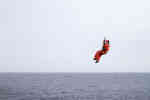Step 2 of 3•4 minutes read
Helicopter Assistance
There are various signals for communication between the helicopter and the people in distress, but no general standards are applied throughout the world. The signals to be used are therefore agreed as far as possible over the VHF radio before the operation starts.
When it is possible, the helicopter crew will often send a rescuer down to the people in distress and he/she will then be responsible for communication. The pilot will always overfly the yacht or the area to ensure that conditions are in order before the operation starts.

Helicopter rescues are used both to rescue a few severely injured people, as well to rescue the entire crew. Photo by: Jörgen Språng.
Evacuation from Yacht and Survival Craft
When evacuating persons from their vessel, a significant risk for the helicopter is masts, rigging or other impediments. Additional risks will arise if the boat is rolling and pitching. The rotor blade downwash from a helicopter reaches hurricane-force speeds. Any loose object on deck can fly into you, your crew or damage the helicopter. The winch operator on the helicopter will send down a harness or stretcher to the deck by using a guideline. Always allow the rescue device to touch the deck before handling it.
During its flight, the helicopter builds up a static electric charge, and anyone who reaches up to take hold of the guideline will get a shock. The guideline must never be fixed onboard the yacht. When the entire crew is rescued from a raft, you should contact the helicopter crew before you release the air from the roof of the raft. The helicopter might not be able to accommodate all persons at the same time, so the raft must continue to protect the remaining persons until all crew members have been rescued. Masts, antennas and such equipment should be taken down when persons are about to be rescued from lifeboats.
Helicopter Pickup
Helicopter rescues are used both when rescuing severely injured people and if the entire crew must be rescued from the vessel or lifeboats and liferafts. Helicopters can use a single lift, a double lift, a basket lift, a stretcher lift or a rescue net lift. Here follows a short description of these lifts.
Single Lift
The single lift is typically a rescue strap. Approach the strap so that it is always between you and the hoisting wire. The strap must lie up under the armpits and the belt must be tightened.
Double Lift
With the double lift, the helicopter sends a man down to fix the rescue strap on the person to be rescued.
Basket Lift
In a basket lift, you sit down in the basket and keep your arms and legs inside it. Bend your head down towards the knees and hold your hands around your knees. Remain calm until the basket is onboard the helicopter.
Stretcher Lift
The stretcher lift is used for the severely injured. A guideline is often used with stretcher and basket lifts to help keep the stretcher or basket free of any obstacles. The guideline must never be fixed onboard the vessel.
Rescue Net Lift
The rescue net has a conical “birdcage” appearance and is open on one side. To use the net, the person merely enters the opening, sits in the net and holds on.

A helicopter harness is the most widely used means for evacuating a person from the sea. Photo by: Jörgen Språng.
Other Rescue Methods
Injured persons on bigger ships are usually rescued from the deck. The helicopter may be able to lift a person from the lifeboat or a liferaft secured on a long painter. However, liferafts have been overturned by the helicopter’s downwash.
Assistance from the Helicopter Crew
The helicopter crew may choose to lower their rescue swimmer to your vessel to evaluate the patient and assist in the hoisting operation. Please support the rescue swimmer and follow his instructions. Every helicopter evacuation at sea is different, and each presents its problems. Communications between pilot and yacht are critical. Operations at night or under poor weather conditions require the utmost caution. In each case, knowing what to expect and how to prepare can save time, effort and possibly a life.
A helicopter harness is the most widely used means for evacuating a person from the sea, survival craft or vessel. The sling is suited for quickly picking up uninjured persons, but are unsuitable for persons with injuries. The sling is put on in the same way as one puts on a coat, ensuring that the loop of the sling passes behind the back and under both armpits. The person using the sling must face the hook. Hands should be clasped in front, over the chest. The person must not sit in the sling and the sling should not be unhooked.